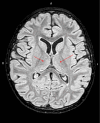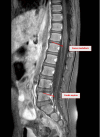Hyperreflexia and Preserved Reflexes in Pediatric Guillain-Barré Syndrome: A Case Report and Literature Review
- PMID: 40600102
- PMCID: PMC12210087
- DOI: 10.7759/cureus.85172
Hyperreflexia and Preserved Reflexes in Pediatric Guillain-Barré Syndrome: A Case Report and Literature Review
Abstract
Guillain-Barré syndrome (GBS) is the most prevalent cause of acute flaccid paralysis, often following an antecedent illness such as upper respiratory infections. Acute motor axonal neuropathy (AMAN), a subtype of GBS, predominantly affects motor axons, resulting in significant motor impairment, and is frequently associated with Campylobacter jejuni infection. We present a case of a three-year-old female patient who developed AMAN, a subtype of Guillain-Barré Syndrome (GBS). Approximately 10 days prior to admission, she had a history of fever, sore throat, and cough, which slightly improved for one day following a five-day course of antibiotics. However, her condition then worsened, and she began experiencing vomiting of gastric contents and occasional sputum production. Despite initial improvement, her condition deteriorated, leading to decreased muscle strength, exaggerated reflexes, and progressive respiratory failure. Neurophysiological studies, including nerve conduction studies (NCSs) and imaging, were consistent with AMAN. The patient was treated with intravenous immunoglobulin (IVIG) therapy and required endotracheal intubation for respiratory support. Over the course of her hospitalization, her neurological status improved significantly, and by day 9, she was able to walk with assistance, marking a successful recovery. This case highlights the importance of early diagnosis and intervention in managing GBS in pediatric patients, particularly in the context of atypical presentations, including hyperreflexia.
Keywords: acute motor axonal neuropathy; aman; atypical presentation; guillain-barré syndrome; hyperreflexia.
Copyright © 2025, Abuhalima et al.
Conflict of interest statement
Human subjects: Consent for treatment and open access publication was obtained or waived by all participants in this study. Conflicts of interest: In compliance with the ICMJE uniform disclosure form, all authors declare the following: Payment/services info: All authors have declared that no financial support was received from any organization for the submitted work. Financial relationships: All authors have declared that they have no financial relationships at present or within the previous three years with any organizations that might have an interest in the submitted work. Other relationships: All authors have declared that there are no other relationships or activities that could appear to have influenced the submitted work.
Figures


Similar articles
-
Plasma exchange for Guillain-Barré syndrome.Cochrane Database Syst Rev. 2002;(2):CD001798. doi: 10.1002/14651858.CD001798. Cochrane Database Syst Rev. 2002. Update in: Cochrane Database Syst Rev. 2012 Jul 11;(7):CD001798. doi: 10.1002/14651858.CD001798.pub2. PMID: 12076424 Updated.
-
Plasma exchange for Guillain-Barré syndrome.Cochrane Database Syst Rev. 2001;(2):CD001798. doi: 10.1002/14651858.CD001798. Cochrane Database Syst Rev. 2001. Update in: Cochrane Database Syst Rev. 2002;(2):CD001798. doi: 10.1002/14651858.CD001798. PMID: 11406009 Updated.
-
Atypical Presentation of Postoperative Guillain-Barré Syndrome in a Pediatric Patient: A Case Report and Review of the Literature.Cureus. 2025 Jun 9;17(6):e85672. doi: 10.7759/cureus.85672. eCollection 2025 Jun. Cureus. 2025. PMID: 40642712 Free PMC article.
-
Case Report: Post-surgical Guillain-Barré syndrome as a rare differential diagnosis of flaccid paralysis of the lower extremities in an infant after cardiac surgery.Front Pediatr. 2025 Jun 6;13:1610035. doi: 10.3389/fped.2025.1610035. eCollection 2025. Front Pediatr. 2025. PMID: 40547133 Free PMC article.
-
Signs and symptoms to determine if a patient presenting in primary care or hospital outpatient settings has COVID-19.Cochrane Database Syst Rev. 2022 May 20;5(5):CD013665. doi: 10.1002/14651858.CD013665.pub3. Cochrane Database Syst Rev. 2022. PMID: 35593186 Free PMC article.
References
-
- Guillain-Barré syndrome. Shahrizaila N, Lehmann HC, Kuwabara S. Lancet. 2021;397:1214–1228. - PubMed
-
- Guillain-Barre syndrome in North Indian children: clinical and serial electrophysiological features. Yadav S, Jain P, Sharma S, Kumar V, Aneja S. Neurol India. 2019;67:724–727. - PubMed
-
- Acute motor axonal neuropathy (AMAN) with motor conduction blocks in childhood; case report. Yildirim S, Adviye R, Gül HL, Türk Börü Ü. https://pmc.ncbi.nlm.nih.gov/articles/PMC4815490/ Iran J Child Neurol. 2016;10:65–69. - PMC - PubMed
-
- Acute motor axonal neuropathy--an atypical presentation. Landau YE, Dabby R, Amir J, Straussberg R. Pediatr Neurol. 2007;36:271–273. - PubMed
Publication types
LinkOut - more resources
Full Text Sources
